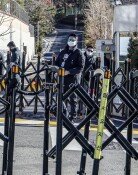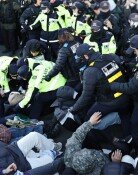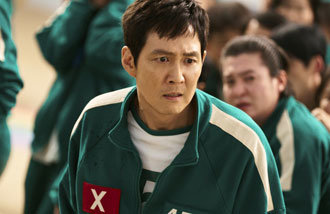Artist Jheon Soo-cheons Line Across America
Artist Jheon Soo-cheons Line Across America
Posted September. 20, 2005 06:42,

A sheet of white polyester fabric measuring 440 meters in length and covering 15 train cars was graying with rain, wind, and dust. The white fabric represents the Nation of White spirit traversing through the American lands, with the train acting as a massive brush.
The artist chose the color white because it is a color that best reflects the ever-changing weather and the nature and civilization that follows it.
The project was realized courtesy of a 5,500-kilometer strip of railroad operated by the American state-funded railroad, Amtrak. A private company called RailCruise lent the passenger train. RailCruise Americas marketing vice-president Jan Andersen said, The event itself is meaningful, of course, but that the American culture which emphasizes safety first would lend track for an artists display is unprecedented. He added, The most difficult thing was to flawlessly schedule the timetable so the train could run at a time when all regular trains vacated the line.
Jheon is a veteran artist who won the 1995 Venice Biennale Special Award. The artist, who had pulled off The Han River Drawing in 1989, a feat which consisted of clothing a tree and sending it floating down the river, first mapped out his Line Across America plan in 1993, seeking reconciliation and conversation between civilizations.
Jheon said, When I studied abroad in the United States, I was impressed by the diverse facets of that alien country. I also felt rebellious toward an American culture that disparaged Asians. I wanted to pierce those inspirations with a train covered in the Korean color of white.
Aboard the train were 100 passengers including cultural experts, renowned artists, and staff. Six civilians also participated.
As the train passed through Pennsylvania and Pittsburgh on the morning of September 15, a Korean-American symposium discussing the meaning of the project was held inside.
Kansas University professor John Feltz expressed his thoughts, saying, Contemporary art was traditionally held in fixed places and definitions, but this project shows that anyone and anything can be an art subject. It is interesting that an outdated transportation means that carries more objects that people can be filled with spirit and civilization.
An English literature professor at Chicago University, W.J.T Mitchell, said, This project is an medium of thought between inside and outside, and explained, Through the train that was once modern in the 19th century but has since been degraded to a mere transportation means, we can see the clash between old and new, machine and state-of-the-art, digital and analog.
Curator Jeong Yeon-shim evaluated, This unprecedented drawing is at once a vestige of American conquerors who moved from East to West, and also a nomadic message to humans used to settlement.
For the project, Jheon was given one billion won by the Ministry of Culture, Hyundai Motors and Samsung Electronics.
The curtain on the project falls on September 21 at 6:00 p.m. upon the trains arrival at Los Angeles Union Station. On the night of September 18, just 68 hours before arriving at Los Angeles, the train passed through Albuquerque, New Mexico. Outside its windows, a full moon shone on the highlands.
Mun-Myung Huh angel@donga.com







